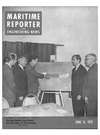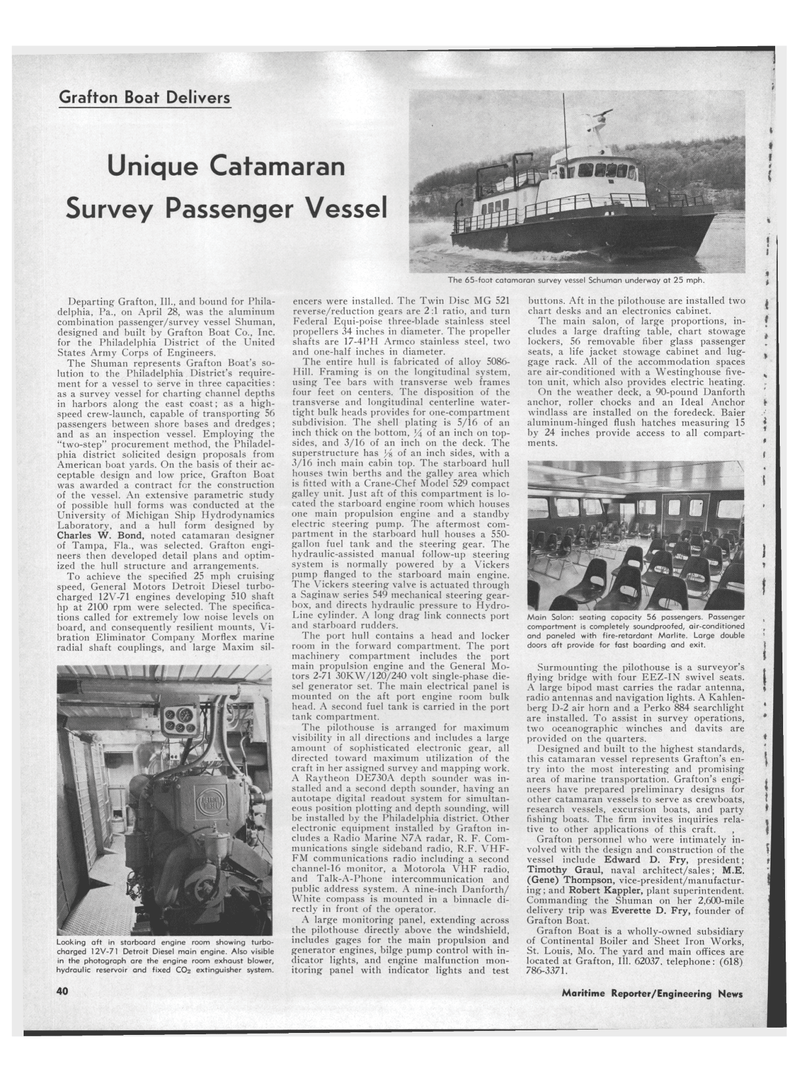
Page 38: of Maritime Reporter Magazine (June 15, 1970)
Read this page in Pdf, Flash or Html5 edition of June 15, 1970 Maritime Reporter Magazine
Grafton Boat Delivers
Unique Catamaran
Survey Passenger Vessel
The 65-foot catamaran survey vessel Schuman underway at 25 mph. encers were installed. The Twin Disc MG 521 reverse/reduction gears are 2:1 ratio, and turn
Federal Equi-poise three-blade stainless steel propellers 34 inches in diameter. The propeller shafts are 17-4PH Armco stainless steel, two and one-half inches in diameter.
The entire hull is fabricated of alloy 5086-
Hill. Framing is on the longitudinal system, using Tee bars with transverse web frames four feet on centers. The disposition of the transverse and longitudinal centerline water- tight bulk heads provides for one-compartment subdivision. The shell plating is 5/16 of an inch thick on the bottom, J4 of an inch on top- sides, and 3/16 of an inch on the deck. The superstructure has J/g of an inch sides, with a 3/16 inch main cabin top. The starboard hull houses twin berths and the galley area which is fitted with a Crane-Chef Model 529 compact galley unit. Just aft of this compartment is lo- cated the starboard engine room which houses one main propulsion engine and a standby electric steering pump. The aftermost com- partment in the starboard hull houses a 550- gallon fuel tank and the steering gear. The hydraulic-assisted manual follow-up steering system is normally powered by a Vickers pump flanged to the starboard main engine.
The Vickers steering valve is actuated through a Saginaw series 549 mechanical steering gear- box, and directs hydraulic pressure to Hydro-
Line cylinder. A long drag link connects port and starboard rudders.
The port hull contains a head and locker room in the forward compartment. The port machinery compartment includes the port main propulsion engine and the General Mo- tors 2-71 30KW/120/240 volt single-phase die- sel generator set. The main electrical panel is mounted on the aft port engine room bulk head. A second fuel tank is carried in the port tank compartment.
The pilothouse is arranged for maximum visibility in all directions and includes a large amount of sophisticated electronic gear, all directed toward maximum utilization of the craft in her assigned survey and mapping work.
A Raytheon DE730A depth sounder was in- stalled and a second depth sounder, having an autotape digital readout system for simultan- eous position plotting and depth sounding, will be installed by the Philadelphia district. Other electronic equipment installed by Grafton in- cludes a Radio Marine N7A radar, R. F. Com- munications single sideband radio, R.F. VHF-
FM communications radio including a second channel-16 monitor, a Motorola VHF radio, and Talk-A-Phone intercommunication and public address system. A nine-inch Danforth/
White compass is mounted in a binnacle di- rectly in front of the operator.
A large monitoring panel, extending across the pilothouse directly above the windshield, includes gages for the main propulsion and generator engines, bilge pump control with in- dicator lights, and engine malfunction mon- itoring panel with indicator lights and test
Departing Grafton, 111., and bound for Phila- delphia. Pa., on April 28, was the aluminum combination passenger/survey vessel Shuman, designed and built by Grafton Boat Co., Inc. for the Philadelphia District of the United
States Army Corps of Engineers.
The Shuman represents Grafton Boat's so- lution to the Philadelphia District's require- ment for a vessel to serve in three capacities: as a survey vessel for charting channel depths in harbors along the east coast; as a high- speed crew-launch, capable of transporting 56 passengers between shore bases and dredges; and as an inspection vessel. Employing the "two-step" procurement method, the Philadel- phia district solicited design proposals from
American boat yards. On the basis of their ac- ceptable design and low price, Grafton Boat was awarded a contract for the construction of the vessel. An extensive parametric study of possible hull forms was conducted at the
University of Michigan Ship Hydrodynamics
Laboratory, and a hull form designed by
Charles W. Bond, noted catamaran designer of Tampa, Fla., was selected. Grafton engi- neers then developed detail plans and optim- ized the hull structure and arrangements.
To achieve the specified 25 mph cruising speed, General Motors Detroit Diesel turbo- charged 12V-71 engines developing 510 shaft hp at 2100 rpm were selected. The specifica- tions called for extremely low noise levels on board, and consequently resilient mounts, Vi- bration Eliminator Company Morflex marine radial shaft couplings, and large Maxim sil-
Looking aft in starboard engine room showing turbo- charged 12V-71 Detroit Diesel main engine. Also visible in the photograph are the engine room exhaust blower, hydraulic reservoir and fixed CO2 extinguisher system. buttons. Aft in the pilothouse are installed two chart desks and an electronics cabinet.
The main salon, of large proportions, in- cludes a large drafting table, chart stowage lockers, 56 removable fiber glass passenger seats, a life jacket stowage cabinet and lug- gage rack. All of the accommodation spaces are air-conditioned with a Westinghouse five- ton unit, which also provides electric heating.
On the weather deck, a 90-pound Danforth anchor, roller chocks and an Ideal Anchor windlass are installed on the foredeck. Baier aluminum-hinged flush hatches measuring 15 by 24 inches provide access to all compart- ments.
Main Salon: seating capacity 56 passengers. Passenger compartment is completely soundproofed, air-conditioned and paneled with fire-retardant Marlite. Large double doors aft provide for fast boarding and exit.
Surmounting the pilothouse is a surveyor's flying bridge with four EEZ-IN swivel seats.
A large bipod mast carries the radar antenna, radio antennas and navigation lights. A Kahlen- berg D-2 air horn and a Perko 884 searchlight are installed. To assist in survey operations, two oceanographic winches and davits are provided on the quarters.
Designed and built to the highest standards, this catamaran vessel represents Grafton's en- try into the most interesting and promising area of marine transportation. Grafton's engi- neers have prepared preliminary designs for other catamaran vessels to serve as crewboats, research vessels, excursion boats, and party fishing boats. The firm invites inquiries rela- tive to other applications of this craft. ,
Grafton personnel who were intimately in- volved with the design and construction of the vessel include Edward D. Fry, president;
Timothy Graul, naval architect/sales; M.E. (Gene) Thompson, vice-president/manufactur- ing; and Robert Kappler, plant superintendent.
Commanding the Shuman on her 2,600-mile delivery trip was Everette D. Fry, founder of
Grafton Boat.
Grafton Boat is a wholly-owned subsidiary of Continental Boiler and Sheet Iron Works,
St. Louis, Mo. The yard and main offices are located at Grafton, 111. 62037. telephone: (618) 786-3371. 40 Maritime Reporter/Engineering News

 37
37

 39
39
